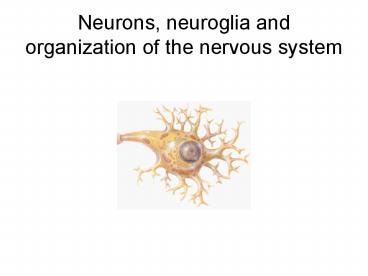Neurons, neuroglia and organization of the nervous system - PowerPoint PPT Presentation
1 / 21
Title:
Neurons, neuroglia and organization of the nervous system
Description:
Neurons, neuroglia and organization of the nervous system Overview of the nervous system General definitions Central nervous system (CNS)- brain and spinal cord ... – PowerPoint PPT presentation
Number of Views:257
Avg rating:3.0/5.0
Title: Neurons, neuroglia and organization of the nervous system
1
Neurons, neuroglia and organization of the
nervous system
2
Overview of the nervous system
3
General definitions
- Central nervous system (CNS)- brain and spinal
cord - Peripheral nervous system (PNS)- links the CNS to
target systems, including sensory organs - Autonomic nervous system (ANS)- spans CNS and
PNS controls visceral functions
4
Functions of the nervous system
- Sensory- detection of internal and external
stimuli (sensory neurons) - Integrative- processing of sensory information
(interneurons) - Motor- response to integrated decision (motor
neurons)
5
Organization of the nervous system
6
Structure and function of neurons
- Act through propagation of action potentials
- Vary considerably in size
- Dendrites, cell body and axons
- May be myelinated
- Synapse with other neuron or muscle cell release
neurotransmitters
7
Neurotransmitter action
- About 100 neurotransmitters known
- Amino acids, polypeptides, gases
- Released into synaptic cleft, bind to membrane of
target cell
8
Structural diversity in neurons
- Multipolar- many dendrites, one axon
- Most neurons in CNS
- Bipolar- one dendrite, one axon
- Sensory organs
- Unipolar- sensory
- Axon termini extend into CNS
9
Neuroglial cells
- Much smaller than neurons and more numerous
- Do not propagate action potentials
- Can replace themselves
10
Four types of neuroglia in CNS
- Oligodendrocytes
- Myelinating cells
- Astrocytes
- Blood-brain barrier (BBB)
- Microglia
- Phagocytes (from bone marrow)
- Ependymal cells
- Line ventricles of brain produce cerebrospinal
fluid (CSF)
11
Neuroglia of the CNS
12
Neuroglia of the PNS
- Schwann cells
- Myelinating cells
- Help direct axon regeneration
- Satellite cells
- Support, protection, regulation of molecular
exchange - Filter out other stimuli
13
Why myelin?
- Increases speed of nerve impulse transmission
- Myelinating cells leave gaps on axons (nodes of
Ranvier) - Schwann cells can help regenerate axons
- Demyelination can lead to loss of function (MS)
14
Classification of neurons
- Exteroreceptors- deal with external environment
- Interoreceptors- deal with internal environment
- Proprioreceptors- position and movement
15
Neuronal circuits
16
Neural circuits in CNS vary in direction and
complexity
- One presynaptic?one postsynaptic is simplest
- One presynaptic? many postsynaptic (divergence)
amplifies a sensory signal - Many presynaptic ?one postsynaptic (convergence)
brings information from many sources into one
pathway - May move repeatedly through circuit
(reverberating)- repeated or learned activities - Parallel-discharge- pathways diverge and then
converge- complex activities requiring
concentration?
17
Repair and regeneration of neurons
- Neurons can grow new dendrites or axon termini
- Repair is limited to certain neurons in the PNS
- Growth factors promote formation of new neurons
limited to specific regions of brain
(hippocampus) in human adults - Growth does occur in fetal and juvenile stages-
what turns it off?
18
Synapses (chemical)
19
Electrical synapses
- Membranes of presynaptic and postsynaptic cells
are fused - Transmission is faster
- Can be bidirectional
- Generally associated with defensive reflexes
20
Gray matter and white matter in the nervous system
21
Medically significant conditions
- Multiple sclerosis (demyelination)
- Epilepsy (uncontrolled electrical discharges)
- Tumors
- Neuropathies- affect specific nerves
- Infectious disease































